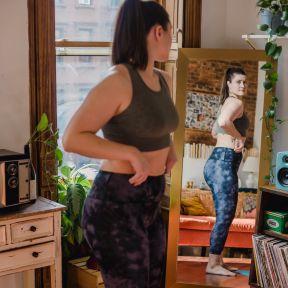BODY IMAGE- Body Dissatisfaction, Body Dysmorphia, and Body Shame Cycles. Megan Fox and 75% of adults report body dissatisfaction. What can help?

KEY POINTS-
- Sadly, 75% of the 13- to 19-year-olds in a 2020 study said they experienced body dissatisfaction.
- In a 2022 study of 824 adults, only 25% reported being satisfied with their body size.
- Body dysmorphic disorder can lead to significant levels of distress, but CBT is one treatment that can help.

Written by Gia Marson, Ed.D.
In today’s culture, anyone can find fault in their weight or shape—even those whom society praises for having an “ideal” body. For example, the actress Megan Fox, who appeared on the cover of Sports Illustrated’s 2023 swimsuit edition, said: “I don’t ever see myself the way other people see me. ... There’s never a point in my life where I loved my body, never ever.”
Body Dissatisfaction
Fox, a successful actress and model, recently revealed that she experienced symptoms of body dysmorphia (BDD), a condition in which one is preoccupied with their perceived physical flaws. She is not alone.
- In 2020, researchers investigated body dissatisfaction among 1,019 adolescents. Sadly, 75% of the 13- to 19-year-olds who participated said they experienced body dissatisfaction.
- Similarly, in a 2022 study of 824 adults, only 25% reported being satisfied with their body size.

Body Dysmorphia
Individuals with body dissatisfaction and body shame rarely meet the full clinical criteria for BDD. While just 2% of adults are diagnosed with BDD, the condition is typically under-recognized and misdiagnosed. The true number of individuals with BDD may be higher. It's important to keep in mind that BDD is not diagnosed in those with specific eating disorders because it is a clinical feature.
BDD leads to “significant distress and/or impairment at work or school” and can correlate with conditions like depression, social anxiety, and more. It can also put you at increased risk of eating disorders and lower self-esteem.
According to the World Health Organization, BDD is characterized by:
- Preoccupation with at least one perceived flaw in appearance that is either unnoticeable or only slightly noticeable to others.
- Excessive self-consciousness, often with ideas of reference.
- Repetitive behaviors (e.g., mirror checking, grooming, picking, and reassurance-seeking) or mental acts (e.g., comparing self with others) in response to their concerns about physical appearance and distressing emotions.
Over their lifetime, individuals with BDD are preoccupied with five to seven different body parts.
Most spend three to eight hours a day preoccupied with their appearance—though 25% will spend more than eight hours a day worrying about how they look.
For those with BDD, it is important to get professional help. The treatment of choice is usually cognitive behavioral therapy (CBT) and medication.
Understanding the Body Shame Cycle
Most people who are struggling with body dissatisfaction don’t meet the criteria for BDD. But no matter where you fall on the spectrum, this sense of body dissatisfaction or body shame does not have to be your story.
It's possible to heal these harmful thought patterns—and get back to the path of self-love and acceptance.
There is no such thing as a “perfect” body.
Our DNA often dictates physical qualities like the shape of our thighs or how we look in a swimsuit.
“We’ve forgotten what a regular body looks like. There are people out there who are struggling, and I’m struggling, and it’s OK to come to terms with realizing it’s going to be a bit of a journey.” —Chrissy Teigen
But in a culture that constantly picks at and judges every aspect of our bodies, it’s difficult not to fixate on our perceived imperfections. Diet and exercise may seem like the only routes to self-acceptance.
But these can be a recipe for disappointment.
Diets and fitness routines fail to work for many people, for many reasons. Sometimes they’re based on dubious science. Other times they require adherence to unrealistic schedules or eating patterns. Sometimes you simply don’t have the time or energy.
None of these reasons make you a failure. But many people feel that way. They criticize themselves for not having enough willpower. They feel ashamed for not being able to “stick to it.”
This shame snowballs into a fear of rejection, which can lead to social avoidance. For example, we don’t show up for a friend’s birthday party because we don’t like how we look in our clothes. We avoid going to check-ups because we don’t want to step on the doctor’s scale. We say no to the beach because we don’t want to be seen in a bathing suit.
This can lead to a cycle of anxiety avoidance. If skipping out on a beach day or birthday party makes us feel better at the moment, it exacerbates feelings of loneliness and reinforces thoughts that we should avoid all future events and gatherings.
But you deserve to live your life—not avoid it.
“The body is such a commodity in our culture. People always comment on your weight. It’s a very shameful thing to take more than your share or take up more space. But now I realize that you’re entitled to that space. You can take up as much space as you want.” —Margaret Cho
Breaking the Body Shame Cycle
In the journey toward self-acceptance, it’s important to focus on the factors you can control.
You can’t change external factors, like how society defines the “ideal” body or what others think of you. But you do have power over your internal experience.
The key to overcoming the shame cycle isn’t to make your body smaller. It’s to make your life bigger.
Focus on relationships.
A crucial part of making your life bigger is finding supportive, positive relationships.
According to one of the longest-running studies on human happiness and longevity from Harvard, positive relationships can have a huge impact on our health.
Think about the people in your life who make you feel good about yourself, then work to spend more time with them.
Pursue actions and goals that have nothing to do with your body.
In a society that obsesses over the “ideal” body—to the point that even famous actors, actresses, and cover models may feel bad about their appearance—it’s easy to fall into the trap of making all your goals body-centric. Stop focusing on body-based goals: stick to that diet; run the 5K; lose the weight.
But if you want to break the cycle of body shame, focus on accomplishments and activities that have nothing to do with how your body looks.
Instead, pick hobbies that challenge your mind and fill your heart. Is there a project at work you’re excited about? Have you ever wanted to try your hand at knitting or painting? Maybe you’ve adopted a dog who would enjoy agility training. Or, stick to that pickleball schedule. Read a book written by your favorite authors. Learn something new.
Cultivate thoughts to give yourself credit.
Celebrating wins can build self-esteem and confidence. And those wins can help you replace cycles of shame with moments of pride.
Be mindful. Pay attention to flow, happiness, and joy.
This can sound so simple. But just pausing long enough to be fully present and recognize moments when you feel good in your life, in your relationships, and in your body can break the shame cycle.
This could be going for a hike, getting into the flow of a new hobby, or spending time with loved ones.
We feel good when we connect with the meaningful aspects of our lives. Whenever you experience that little whoosh of positive feeling, notice it. Lean into it. And try to reproduce the situation as much as possible.
If you feel at your best when you’re in nature, how can you get outside more often? If you feel at peace when you’re with your best friend, could you schedule more time with that person?
Actively reinforce what feels good.
To reinforce it, write down one thing that makes you feel good each day that has nothing to do with your body. Rather than obsessing about how you wish you might look, start tracking it when you feel engaged, connected, happy, joyful, and accomplished.
As you notice these instances more, you can replicate them more—and get back to living a life dictated by happiness and self-esteem, not just the shape or size of your body.
- Questions and Answers
- Opinion
- Motivational and Inspiring Story
- Technology
- Live and Let live
- Focus
- Geopolitics
- Military-Arms/Equipment
- Security
- Economy
- Beasts of Nations
- Machine Tools-The “Mother Industry”
- Art
- Causes
- Crafts
- Dance
- Drinks
- Film/Movie
- Fitness
- Food
- Games
- Gardening
- Health
- Home
- Literature
- Music
- Networking
- Other
- Party
- Religion
- Shopping
- Sports
- Theater
- Health and Wellness
- News
- Culture

